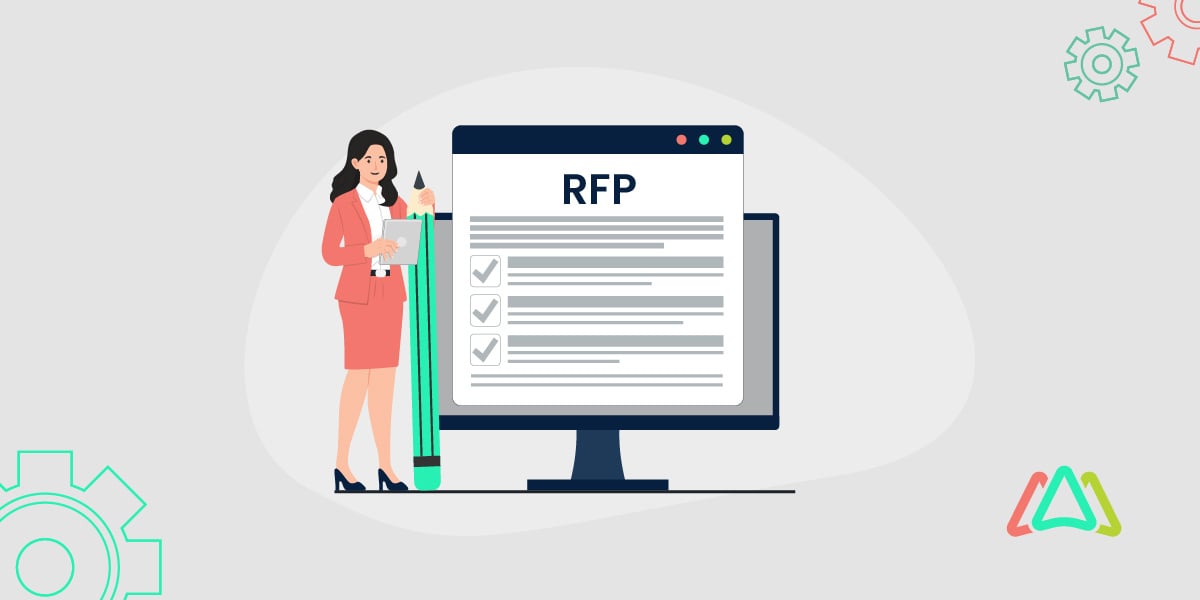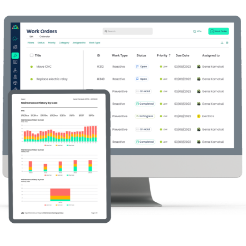
CMMS Request for Proposal (RFP)
When your organization decides to invest in a CMMS (Computerized Maintenance Management System), the stakes are high. The right solution can streamline operations, minimize downtime, and significantly boost efficiency. However, for some organizations without a well-established RFP process for selecting B2B software or for those not familiar with CMMS software applications, the process can be overwhelming. A well-structured CMMS Request for Proposal (RFP) serves as your roadmap, guiding you through this complex decision-making process.
An RFP acts as a blueprint for your decision-making process, ensuring that your organization clearly communicates its needs to vendors and receives tailored solutions in return. It’s not just about finding any software; it’s about identifying the right software to meet your organization’s unique goals and drive long-term success. A thoughtfully designed CMMS RFP doesn’t just save time; it ensures smooth implementation, operational improvements, and long-term success.
What is a CMMS Request for Proposal (RFP)?
A CMMS Request for Proposal (RFP) is a formal document businesses use to communicate their specific requirements when selecting a Computerized Maintenance Management System. Unlike a general RFP, a CMMS RFP focuses on maintenance goals, operational challenges, and desired software functionalities.
Businesses issue an RFP for CMMS to ensure clarity and transparency in the vendor selection process. It helps organizations outline their needs in detail, compare multiple vendors effectively, and evaluate solutions that align with their unique goals. By issuing an RFP, businesses can avoid guesswork and ensure every potential vendor provides a tailored response that addresses their operational challenges.
Ultimately, a CMMS RFP plays a critical role in streamlining maintenance processes. It ensures the organization selects a solution that optimizes efficiency, reduces downtime, and supports long-term success.
The Role of RFPs in CMMS Selection
A Request for Proposal (RFP) is an effective process for organizations seeking a comprehensive, structured approach to selecting a Computerized Maintenance Management System (CMMS). While it offers numerous benefits for complex, high-value projects, it may not always be the best fit for simpler or more urgent requirements. Let’s explore the pros and cons of using an RFP, the situations in which it is suitable, and when it should be avoided.
Key Advantages of Using an RFP for Purchasing a CMMS
An RFP provides a formal framework for assessing CMMS vendors and their products. It ensures a systematic and objective approach, helping organizations make informed, confident decisions. Evaluating CMMS software options through a formal RFP process has many advantages.
- Structured Vendor Evaluation:
An RFP creates a standardized process to compare vendors side-by-side based on pre-defined criteria, such as functionality, integrations, and costs. A key advantage of this structured evaluation is that it reduces bias and ensures that all vendors are assessed on the same criteria.
- Alignment with Business Needs:
An RFP ensures that solutions address the organization's goals by requiring stakeholders to document their specific needs and challenges. This upfront clarity minimizes the risk of purchasing a system that doesn’t fully meet expectations.
- Competitive Pricing and Features:
Vendors respond to RFPs by offering tailored proposals, often including competitive pricing, discounts, or favorable terms to win the business. Organizations can leverage this competition to negotiate better terms and add-ons that are often not available if the standard purchasing process is used.
- Transparency and Documentation:
The RFP process provides a written record of requirements, evaluations, and vendor communications, ensuring accountability. This is especially important for organizations needing to justify decisions to upper management, stakeholders, auditors, or regulatory bodies.
- Minimizes Risk:
An RFP helps identify potential risks, such as insufficient vendor support, hidden costs, or incompatibility with existing systems, by documenting every step and carefully evaluating each proposal. This proactive approach reduces the chances of post-implementation surprises.
Key Advantages of Not Using an RFP for Purchasing a CMMS
The key benefit of skipping the RFP process is that it saves time. This is the practical choice for organizations with simpler needs or urgent timelines. The following are key advantages of avoiding the RFP process when selecting a CMMS.
- Faster Decision-Making:
Skipping the formalities of the RFP process can save a lot of time, allowing the organization to choose and implement a solution faster. This is critical for companies facing immediate operational challenges or compliance deadlines. From start to finish, an RFP process can take 3-12 months, depending on the complexity of the purchase and the size of the team that is involved.
- Flexibility in Vendor Interaction:
Direct engagement with vendors fosters more dynamic conversations, enabling more interactive software demos, custom trials, and iterative feedback. This informal process can uncover creative solutions that might not emerge in a rigid RFP framework.
- Less Resource-Intensive:
Preparing an RFP involves significant time and effort from multiple teams. This is especially true for organizations with limited experience with RFPs and those whose RFPs are not standardized for software evaluations. Many organizations have standard RFPs that cater to professional services and products that are not related to software. If these are used, a lot of time and resources are required for changes and edits so that the RFP and contract terms can be used for software. For smaller organizations or straightforward requirements, going through an RFP process may not be justified. Directly researching and shortlisting vendors can be more cost-effective.
- Focus on Relationships:
By skipping the RFP process, organizations can build stronger, more personal relationships with vendors, leading to improved collaboration and support post-implementation. Vendors are often more flexible and responsive when there’s an ongoing dialogue instead of a rigid submission process.
When is a CMMS RFP Suitable?
An RFP is best suited for situations with complex requirements, substantial budgets, or essential transparency.
- Complex Needs:
An RFP ensures that vendors address the organization's specific requirements for advanced features, multiple integrations, or industry-specific capabilities in their proposals.
- Multiple Stakeholders:
When various departments or teams (e.g., operations, IT, finance) have different priorities, an RFP provides a framework for consolidating and balancing these needs.
- Significant Investment:
For high-cost purchases, an RFP demonstrates due diligence and helps justify the investment to leadership or stakeholders.
- Regulated Environments:
In industries like healthcare, utilities, or government, an RFP is often required to meet compliance, procurement, or transparency standards.
- Vendor Agnosticism:
If the organization has no prior experience with CMMS vendors or wants to explore a broad range of options, an RFP ensures an impartial and thorough selection process.
When is an RFP Not Suitable?
In certain scenarios, the RFP process may be unnecessary or counterproductive, particularly when simplicity and speed are priorities.
- Tight Timelines:
If the organization needs to implement a CMMS urgently due to operational or compliance pressures, the lengthy RFP process may not be feasible.
- Straightforward Requirements:
When the organization’s needs are basic and well-understood (e.g., work order tracking, asset inventory), a quick evaluation of off-the-shelf solutions may suffice.
- Limited Budget:
Small businesses or organizations with tight budgets may find the cost and resource demands of managing an RFP process outweigh the potential benefits.
- Existing Vendor Relationships:
If the organization has a trusted vendor with a proven track record, it may be more efficient to negotiate a solution that meets current needs directly.
- Rapidly Changing Market:
In industries with fast-paced innovation, an RFP’s long timeline could result in missing out on emerging solutions or newly released features.
Why is a CMMS RFP Important?
A CMMS Request for Proposal (RFP) is essential for organizations looking to make a strategic and informed decision when selecting maintenance software. It bridges the gap between the organization’s business needs and the features offered by CMMS vendors. By outlining your specific requirements upfront, an RFP ensures vendors understand your goals and provide tailored solutions that align with your objectives.
One of the greatest advantages of a CMMS RFP is its ability to bring structure and objectivity to the vendor selection process. It eliminates guesswork and ensures all proposals are evaluated based on the same criteria, leading to fair and transparent decision-making.
Moreover, a well-crafted RFP prevents costly mistakes by clarifying expectations early on. This saves time and resources by avoiding mismatched software that could disrupt operations or require expensive adjustments later. Simply put, a good RFP sets the foundation for long-term success.
Key Elements of a CMMS RFP
A well-structured CMMS RFP template ensures your organization communicates its requirements clearly to potential vendors. To create an effective RFP, include the following essential elements:
Introduction and Background
Provide an overview of your organization, its industry, size, and current maintenance challenges. For example, describe inefficiencies in asset tracking or difficulties with preventive maintenance that the CMMS should address.
Objectives and Goals
Define your desired outcomes, such as reducing downtime, improving asset reliability, or streamlining work orders. This helps vendors tailor their solutions to your specific goals.
Scope of Work
Outline the vendor’s expected responsibilities, including system implementation, training, ongoing support, and integration with existing systems like ERP or IoT devices.
Technical and Functional Requirements
Include detailed must-have features like inventory management, reporting capabilities, mobile accessibility, and preventive maintenance scheduling. If applicable, mention scalability or integration needs.
Implementation Timeline
Specify your preferred deployment schedule, including major milestones like system installation, testing, and staff training.
Budget and Cost Structure
Provide a clear budget range and request pricing transparency. Encourage vendors to use a pricing matrix that breaks down costs into licensing, training, support, and upgrades.
Evaluation Criteria
Describe how proposals will be assessed. For instance, include criteria such as vendor experience, software functionality, cost-effectiveness, and scalability.
By including these key elements and structured attachments, your CMMS RFP becomes a comprehensive guide for vendors, ensuring you receive tailored proposals that align with your organization’s goals and needs.
How to Create a CMMS RFP
Creating a CMMS RFP involves a strategic approach to ensure it addresses your organization’s unique needs. Follow these steps to craft an effective CMMS RFP:
1. Identify Your Goals and Challenges
Start by pinpointing your maintenance challenges and business objectives. What are you trying to improve—asset management, downtime reduction, or operational efficiency? This clarity will serve as the foundation for your RFP and guide vendors in meeting your needs.
2. Define Technical and Functional Requirements
List the specific features you need, such as work order management, asset tracking, and mobile accessibility. Prioritize your requirements and clearly highlight the must-have features. This helps vendors understand your expectations and focus on delivering the most relevant solutions.
3. Be Clear and Concise
Outline your expectations in straightforward terms to avoid confusion. Clearly state your business goals, software requirements, and any non-negotiable elements to ensure vendors know exactly what you’re looking for.
4. Ask the Right Questions
Include key questions for vendors, such as their approach to scalability, integration, and ongoing support. Request detailed demonstrations of their CMMS solution and vendor references to gain valuable insights into their reliability and performance.
5. Address Implementation Challenges
Encourage vendors to proactively outline how they would tackle potential implementation issues, such as integration with your existing systems or training your team. Their responses will showcase their problem-solving capabilities and commitment to a smooth transition.
6. Include Evaluation Metrics
Establish clear criteria for assessing vendor responses. Metrics such as cost, scalability, and ease of use can help you objectively compare proposals and select the best fit for your organization.
7. Customize to Your Organization’s Needs
No two organizations are the same. Customize your RFP to reflect your unique requirements, ensuring it serves as an effective tool in simplifying the selection process and securing a CMMS solution aligned with your goals.
By following these steps and considering the key elements discussed earlier, you can create a CMMS RFP that simplifies your selection process and ensures you find the best fit for your organization’s goals.
Common Mistakes to Avoid in a CMMS RFP
Several common mistakes can be avoided when creating a CMMS RFP. First, overcomplicating the document can lead to confusion and unnecessary delays. Keep the language clear and straightforward, focusing on the most important aspects of the software you need.
Another mistake is failing to involve key stakeholders early in the process. Different departments, such as IT, operations, and maintenance, may have specific requirements that should be addressed in the RFP. Not consulting them could result in overlooking critical needs.
It’s also essential not to overlook scalability and future-proofing. Your organization’s needs will evolve, so choosing a CMMS that can grow with you is important. Failing to consider this can lead to the software becoming obsolete as your operations expand.
Lastly, not providing enough details for vendors can lead to vague proposals that don’t meet your expectations. Offer enough information so vendors can craft a proposal that aligns with your goals and challenges.
Benefits of Using a CMMS RFP Template
Using a CMMS RFP template offers several key benefits that streamline the selection process. First, it saves time by providing a clear structure that can be reused across multiple vendor evaluations, reducing the effort needed to draft new RFPs each time. It also ensures consistency across your proposals, making it easier to compare responses objectively.
Using a template, vendors can clearly understand your needs, leading to more accurate and tailored responses. This can prevent misunderstandings or mismatched proposals that don’t address your requirements.
The template also simplifies the comparison of proposals, allowing you to evaluate each vendor using the same criteria. This makes it easier to determine which software best aligns with your goals.
Ultimately, using a CMMS RFP template supports better decision-making. With all relevant details clearly laid out, you can confidently choose the solution that will deliver the most value for your organization.
How to Evaluate CMMS RFP Responses
When evaluating CMMS RFP responses, consider several criteria to ensure a good fit for your organization. Vendor experience and reputation are necessary; look for vendors with proven success in your industry. Next, assess software functionality and ease of use; the system should align with your business needs and be intuitive for users.
Conduct a cost and ROI analysis to ensure the solution is within budget and provides long-term value. Additionally, evaluate post-implementation support and training to ensure the vendor offers ongoing assistance.
Conclusion
Creating a detailed CMMS RFP is important for ensuring you select the right software solution that aligns with your organization's needs. A well-structured RFP helps you clearly communicate your requirements, compare vendor proposals, and make an informed decision.
To get started, consider using a CMMS RFP template to simplify the process and ensure consistency. By downloading our free CMMS RFP template, you can streamline your decision-making and set your organization up for success.
TABLE OF CONTENTS
Keep Reading
Last month, news outlets and the entire internet was abuzz with the return of NASA astronauts ...
3 Apr 2025
What comes first - CMMS or predictive maintenance? If your answer is either, it is correct. ...
28 Mar 2025
Artificial intelligence (AI) talk has become commonplace. Today, engaging in business-focused ...
27 Mar 2025
Imagine a world where machines predict, diagnose, and fix their issues before they fail. This ...
25 Mar 2025
A facility maintenance plan is at the core of a facility’s operations. This organized ...
21 Mar 2025
Think of managing your maintenance operations like managing a championship sports team. Just ...
21 Mar 2025
The maintenance sector is battling a severe talent shortage that threatens to undermine ...
7 Mar 2025
Manufacturing maintenance is the backbone of industrial efficiency, ensuring machines run ...
5 Mar 2025
No one likes playing a guessing game when equipment breaks down. Yet, maintenance teams often ...
4 Mar 2025
The size of the preventive maintenance software market is discussed in millions of dollars, ...
4 Mar 2025
The organizational structure and corporate hierarchy vary from company to company. Large ...
28 Feb 2025
Maintenance procedures are essential for ensuring the longevity and reliability of machinery ...
21 Feb 2025
Sustainability is no longer just a buzzword; it's a critical component of corporate social ...
20 Feb 2025
A Computerized Maintenance Management System (CMMS) relies on accurate, well-organized data ...
18 Feb 2025
In an era where technology drives operational efficiency, Computerized Maintenance Management ...
14 Feb 2025
A Computerized Maintenance Management System (CMMS) is a key component of modern maintenance ...
13 Feb 2025
Introduction Maintenance management is the foundation of maintenance operations in industries ...
11 Feb 2025
Introduction A Computerized Maintenance Management System (CMMS) is software designed to help ...
7 Feb 2025
Introduction Due to a growing awareness of the need to combat climate change, the green ...
6 Feb 2025
Introduction Selecting the right Computerized Maintenance Management System (CMMS) is a ...
31 Jan 2025






